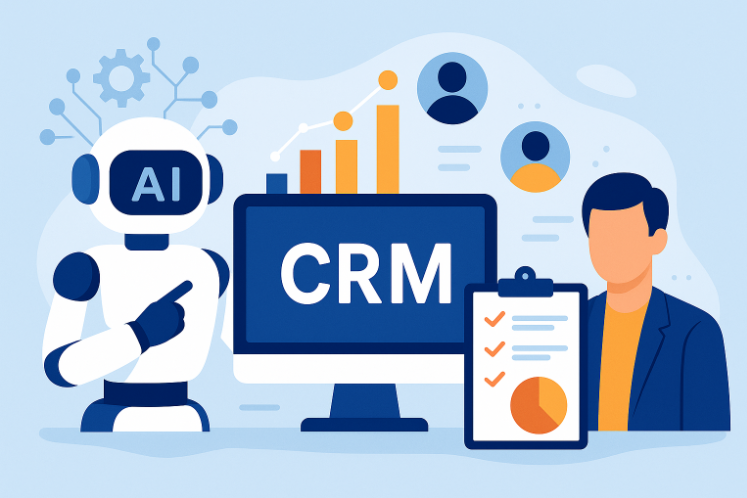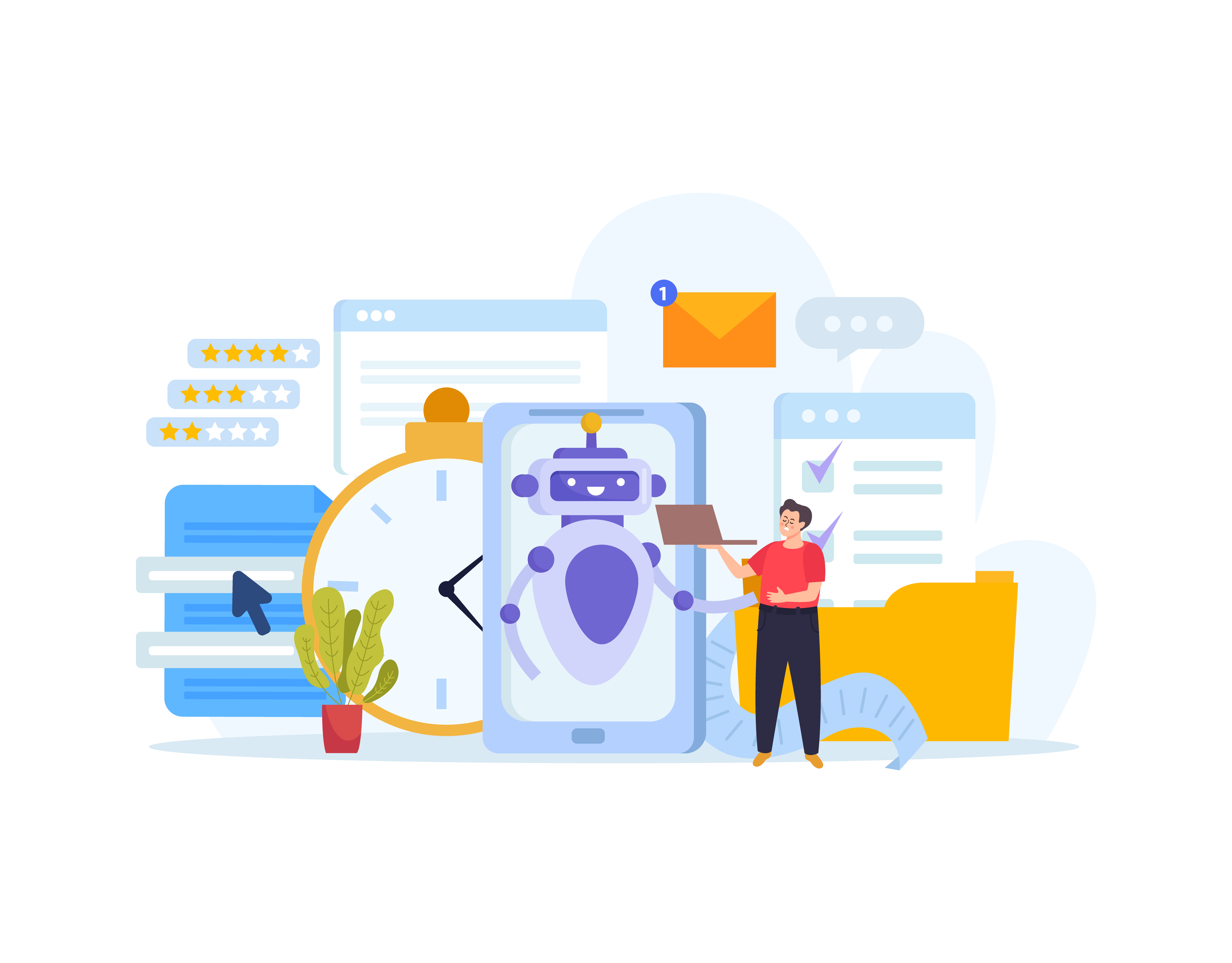Artificial Intelligence and CRM: Automating Lead Scoring, Follow-Ups, and Insights

Let’s be real Artificial Intelligence and CRM have come a long way from being just a fancy contact list. You log names, track calls, and maybe send a reminder to follow up. But in today’s world, that’s nowhere near enough. Businesses need tools that don’t just store info they need systems that think.
That’s where Artificial Intelligence steps in. When you combine AI with CRM, it’s not just about being efficient. It’s about being smarter. Smarter with your time, smarter with your customers, and smarter with your sales strategy.
Instead of wasting time manually guessing which leads might be worth your attention, AI does the heavy lifting. It sifts through mountains of data—web clicks, email opens, meeting notes—and tells you who’s ready to buy.

What Is AI in CRM?
Think of it like this: your regular CRM takes notes. An AI-enhanced CRM? It reads those notes, draws conclusions, and taps you on the shoulder when something important happens.
It uses tools like machine learning, predictive analytics, and natural language processing to get ahead of the curve. That way, instead of reacting to your customers, you’re already one step ahead.
Why Bother with AI Lead Scoring?
You’ve probably heard the term “lead scoring” tossed around. Basically, it means ranking your leads based on how likely they are to convert.
But here’s the kicker AI makes it ridiculously accurate.
Rather than basing it on gut feeling or a couple of metrics, AI looks at patterns you didn’t even realize were there. Maybe it notices that people who watch your product webinar and download your whitepaper convert 3x more. That’s insight you wouldn’t catch manually.
Now, instead of juggling a hundred maybe-leads, you can zoom in on the ten that are most likely to sign the deal.
Let’s Talk Follow-Ups
Following up can feel awkward. You don’t want to seem too pushy, but you also don’t want to wait so long that they forget you exist.
AI in CRM takes that guesswork out of it. It tracks response behavior, reads between the lines of past emails, and even picks up on sentiment. Then it nudges you with something like: “Hey, Tuesday at 10 AM might be a good time to check in with Sarah.”
It’s like having a personal assistant who reads your clients’ minds (but less creepy).
What Happens When AI and CRM Work Hand in Hand?
So, how exactly do these two systems play off each other? Let’s break it down into a few key areas:
1. Smarter Lead Scoring—Without the Headache
Traditionally, sales reps had to sift through spreadsheets, past emails, and website visits to figure out which leads were “worth it.” It was part data science, part guessing game.
Now? AI does it in seconds.
It looks at a bunch of signals—site visits, email clicks, previous purchases—and scores each lead behind the scenes. By the time a sales rep opens their dashboard, they already know who’s warm and who’s ice cold.
No more “spray and pray.” Just precision targeting.
2. Predictive Follow-Ups That Work
Everyone knows follow-ups matter, but knowing when to follow up and how to do it. That’s where AI comes in.
Instead of setting a generic reminder, your CRM might say, “Hey, this prospect usually replies within 3 hours—send them a short email now.” It considers:
- Your prospect’s past response patterns
- Their preferred communication channels
- The tone of previous conversations
It’s not magic. It’s just smart software that learns what works.
3. From Data to Direction: Real-Time Recommendations
Sure, your CRM tracks data. But AI takes it a step further—it gives you suggestions based on that data. Here’s what that might look like:
- “This client’s browsing behaviour suggests they’re ready for Product B”
- “This account hasn’t engaged in 3 weeks—they might churn soon”
- “Clients like this usually respond better to product demos than cold calls”
Instead of digging through reports, you get insights you can act on now.
A Real-World Use-case: How One B2B Team Uses AI and CRM
Let’s say you’re a software company with a decent-sized sales team.
- A new lead signs up for your webinar
- They read a few blog posts, click a follow-up email
- Behind the scenes, AI bumps their score
- The CRM alerts your sales rep: “This one’s ready”
- The system suggests some talking points based on what they’ve viewed
- After the meeting, it drafts a custom follow-up email
You just saved a ton of time and made the experience feel tailored
What to Look for in an AI-Driven CRM
Alright, so you’re convinced AI can give your CRM a serious boost. But what features should you be looking for?
Here’s a quick checklist:
- Lead scoring that learns as you go – The more data your system gets, the smarter it becomes
- Follow-up reminders that feel timely, not robotic – Think: “Call Jake Tuesday at 11” based on his past behavior
- Email and call analysis using real language processing – So you don’t miss subtle cues in tone or sentiment
- Forecasting tools that don’t just guess – Accurate projections based on patterns, not hunches
- Customer sentiment tracking – Know when a client’s engagement is slipping before they disappear
- Helpful nudges – Suggestions on what to do next, backed by data
- Smooth integration – It should plug into your marketing tools and sales platforms without a fight
Platforms like InsightsCRM are baking these features to help teams work smarter, not harder.
Why It’s a Game-Changer for Finance and Capital Markets
Let’s talk about high-stakes industries—like finance, asset management, and capital markets—where relationships and timing can make or break a deal.
In these sectors, AI-powered CRMs aren’t just helpful. They’re critical.
Imagine being able to:
- Spot which institutional clients are cooling off—before a competitor swoops in
- Get real-time feedback on how a pitch landed (based on tone and response)
- Automatically update deal pipelines without manual data entry
- Forecast revenue from specific accounts with surprising accuracy
This isn’t theoretical. These tools are already helping sales traders, bankers, and analysts stay sharp and win more business.
Tackling the Common AI Roadblocks
Of course, adopting AI in CRM isn’t always plug-and-play. You’ll want to be ready for a few common bumps:
- Messy data: AI only works if your CRM data is clean. So yeah, a little spring cleaning might be in order first
- Team hesitation: Some folks might be wary of relying on algorithms. Show them how it makes them better, not obsolete
- Tech fit: Choose a CRM that plays well with your existing stack. Don’t fall for shiny features that don’t work with your setup
Start small. Test. And let the results speak for themselves.
What’s Coming Next in AI + CRM
We’re just at the beginning. Over the next few years, expect AI to get even more embedded in your day-to-day workflow.
What’s on the horizon?
- Voice-to-text and real-time conversation coaching – Think smart assistants that take notes and offer suggestions mid-meeting
- Relationship mapping – Know who influences whom in large accounts
- Hyper-personalized messaging – Your email campaigns won’t just be personalized—they’ll feel custom-written
- AI-driven coaching – Reps get feedback based on what worked (or didn’t) in past deals
The future of CRM isn’t just automated—it’s adaptive and surprisingly intuitive.
Final Thoughts: Time to Stop Guessing and Start Scaling
If your team is still manually chasing leads, juggling follow-up notes, or guessing which accounts need attention… It’s time for a change.
AI-powered CRM isn’t about replacing your people. It’s about amplifying them—giving them better tools to do their best work.
And let’s be honest: in a world where your competitors might already be using these tools, waiting could cost you more than just a few deals. Ready to Upgrade?
InsightsCRM is built on AI-powered tools that help sales, marketing, and relationship teams move faster, work smarter, and connect more deeply with clients.
From lead scoring to pipeline forecasts to smart follow-ups—we’ve got the tech to help your team shine.
